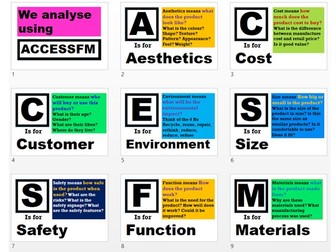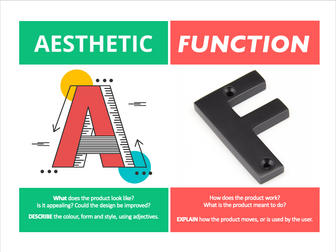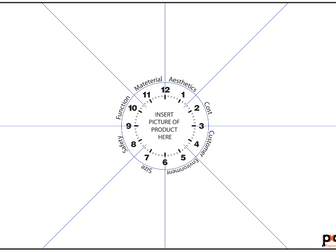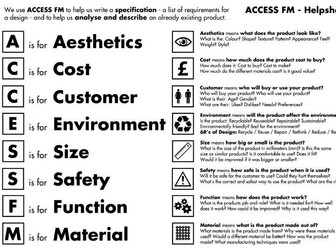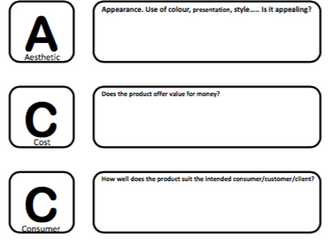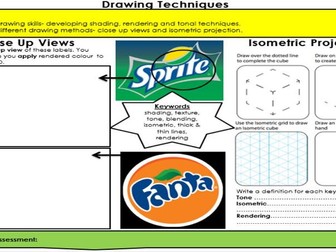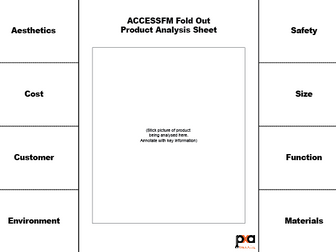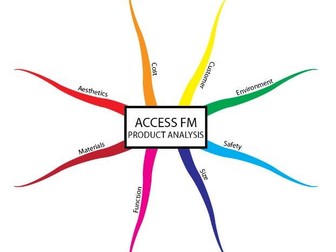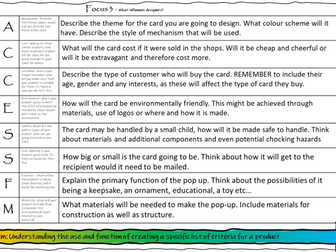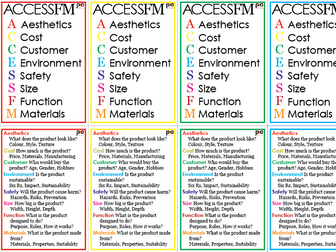
ACCESSFM poster for product analysis
I use this all the time to get my students to consider aesthetic, cost, customer, environment, size, safety, function and materials. Really handy for product analysis, making sure they have labelled everything in design work, and also for covering these key points when writing their design specifications.

Advanced ACCESSFM Placemat
Beyond ACCESSFM! This is a version more suitable for ks4. Set up to write a specification but can be turned to brief analysis, evaluation or labeling pretty easily. Presented in a placemat setup to link with the regular ACCESSFM one.

ACCESSFM
A Powerpoint presentation that explains the matters that effect design. ACCESSFM is really good and easy to remember

ACCESSFM Product Analysis Help sheet Differentiated
Help sheet that explains the different parts of the ACCESSFM acronym with a number of questions. The sheet can be printed one sided for high ability students but it also has an another side which can be printed 2 sided to differentiate for lower ability students in the group. this side gives more information and what they should be looking for and commenting on.
undefined

ACCESSFM Revision Clock - Product Analysis Tool
A revision clock is a innovative method of getting pupils to split their time up in a lesson or at home when revising and to break larger topics down into manageable chunks. Pupils have a limited time to write down facts about a given topic. In this case the hour is split into the eight sections of ACCESS FM. Pupils would start at Aesthetics and would have 7.5 minutes to fill that section before moving on. This resource can be used to revise ACCESS FM or can be used to perform a quick yet effective product analysis. Use this tool to help ensure you have a quick paced lesson.
ACCESS FM is useful product analysis tool can be used for a variety of technology based subjects including Design Technology & Engineering. Is is useful at all Key Stages.
There are two file types available and can be easily edited to ensure that it is suitable for your subject/specification.

ACCESSFM CARDS
A visual aid to help learners develop an understanding of A.C.C.E.S.S.F.M whilst designing a mobile phone product. I have found them to be a great tool for differentiation and catered to suit all abilities. They contain visual imagery as well as questions to aid thinking . I have laminated sets in the class and I have them permanently displayed on the whiteboard. I have found these are useful for both KS3 & KS4.

ACCESSFM Helpsheet
ACCESSFM helpsheet I made for KS3 and KS4 to aid students when doing specifications of evaluations. Perfect for differentiation and whole class understanding.
Enjoy!

ACCESSFM Analysis Sheet
A great tool to help students conduct a product analysis. The sheet helps students to organise the analysis and guides them to address each of the analysis points.

KS3 Design Technology Drawing Skills & ACCESSFM SOW & Student Booklet
Introduce your new Year 7’s to the core principles of Design Technology including ACCESS FM, drawing skills, presentation techniques and environmental issues. This premium resource incudes the lesson powerpoint and student work booklet and is in line with the NEW D&T curriculum assessment criteria (see My Shop for KS3 Assessment Map).
In my dept we spent 2x 2 hour lessons to complete this booklet and then used an internal moderation to set pupils into ability groups for the year based on their completed booklet but it could be adapted to a variety of delivery methods. You could also use this unit of work as an introduction to drawing skills for a Graphics unit in KS3. Hope you find it useful please leave a review :)

ACCESSFM in Engineering - Flash Cards - Product Analysis & Design Specification Tool
This activity could be used to support a product analysis tasks or a start helping pupils to learn about ACCESS FM. All you need to do is cut out the front and back of the cards, stick them together and laminate!
If you would like a pre-printed and laminated version of this resource, visit my ebay shop! pxaengi_58

Product Analysis ACCESSFM cards
An updated resource that aids delivery of Product Analysis lessons. These are a set of double sided A5 learning cards that help learners develop an understanding of the ACCESSFM acronym. One side contains images and key words and the other includes a description, Sentence starters and product analysis questions. These cards enable differentiation and help learners with ALN develop their knowledge. Literacy is also developed through the use of sentence starters.

ACCESSFM Fold Out Product Analysis Sheet
This is a quick and effective resource for performing a product analysis using ACCESSFM, or a method to learn and revise the key ACCESSFM terms. Simply print on to A3 (double sided) and cut along the lines between each key word. Fold the tabs over so they cover the boxes.
Pupils are give an amount of time (I suggest five minutes per box) to write write a sentence or paragraph about the product in each box. There is also room on the back for pupils to include a picture of the product being analysed and to annotate it with key information.

ACCESSFM Mind Map - Product Analysis Tool
A mind map is a creative way of visually organising information. Originally created by Tony Buzan this is a widely used method that users to explore a single topic or idea. Check out https://imindmap.com/how-to-mind-map/ to see how to mind map correctly.
This mind map provides a starting point for pupils to explore ACCESSFM. It could also be used to perform a product analysis on an existing product, by adding information to each key branch.
There are five key steps to creating a successful mind map:
Start with a central image (you can replace the text on this document)
Add branches to your map (these should be curved and start thick and end thin)
Add key words (one key word per branch)
Colour code branches (Easy to organise and visually appealing)
Include images (1 picture is worth a thousand words)
Two file types are included that can be easily edited to suit your lesson.

ACCESSFM and MUMSFACES double sided book mark
I've made this as a resource for my GCSE students.
This has the acronyms 'ACCESSFM' and 'MUMSFACES' on it with explanations about each one:
eg:
M = Materials. What materials will your product be made out of? What are their properties etc.
For use with product analysis and designing.

Lesson 9 Pop Up Card Project - ACCESSFM specification
Students will use the acronym ACCESSFM to help them to formulate a basic specification for their product. They will look at each aspect of a product and outline their intention for the product that they are going to design and make.

ACCESSFM in Engineering - Single Flash Cards - Product Analysis & Design Specification Tool
This activity could be used to support a product analysis tasks or a start helping pupils to learn about ACCESS FM. All you need to do is cut out the front and back of the cards, stick them together and laminate!
If you would like a pre-printed and laminated version of this resource, visit my ebay shop! pxaengi_58

Specification Toolkit Generation (User & Client, & ACCESSFM) KS3,4,5
Two DESIGN AND TECHNOLOGY / PRODUCT DESIGN resources here!
KS3 - Toolkit/worksheet to support students generating their own design specification through using ACCESSFM.
GCSE and ALevel students to support the generation of a design specification.
Worksheets provides questions and prompts to enable individual thinking.
Toolkit graphics are available as seperate transparent .png for use in supporting documents and presentaions.

Product analysis A.C.C.E.S.S.F.M writing frame
Students use this resource to analyse a product using the A.C.C.E.S.S.F.M writing frame which has been differentiated to cover 3 different target levels.
Key for the students include:
Black font - Students either copy the sentence starter or answer the question
Purple font - Students use the keyword within their sentence
Orange font- explains the sentence in more depth
